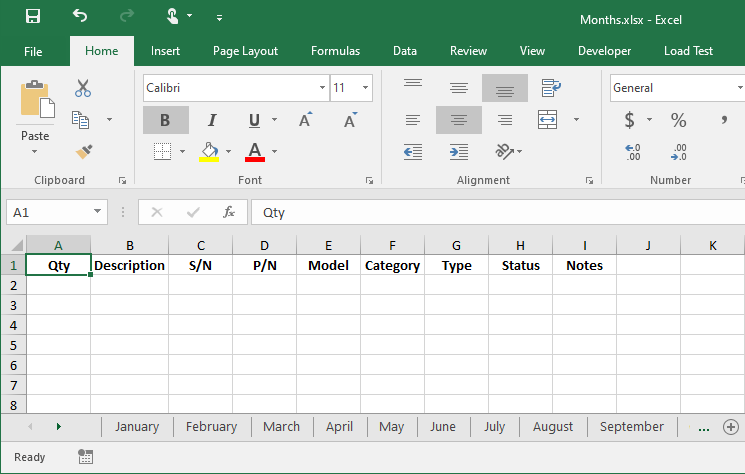Greetings all,
I am currently working on a program that interfaces with my Access DB.
The program is a front-end GUI, to retrieve information from the DB via SQL queries.
What I am attempting:
A user clicks a button, which will then generate an inventory list from the DB and dump it all to an Excel file.
What I have so far:
Currently, I have a functional portion of the code that works. I use the button click event to trigger the calls for connecting to the DB, performing the query, creating an Excel book and sheet, and dumping the gathered data to that sheet.
Where I want to go:
I need to generate sheets in the workbook based on a list of names that will be supplied when the user clicks the button.
I am trying to figure out how to generate the sheets, and name them, according to the List that will be passed with the call.
The Code Portions:
private void btnTEST_Click(object sender, EventArgs e)
{
var timeStamp = DateTime.Now.ToString("yyyy-MMM-dd");
string.Format("{0:yyyy-MMM-dd}", timeStamp);
string categoryName = "Units";
string modelName = "Bolt-Gun";
string typeName = "Source";
string q_SOURCE = @"SELECT tblOwnedInventory.Qty, tblOwnedInventory.Description, tblOwnedInventory.SerialNumber, tblOwnedInventory.PartNumber, tblModel.Model, tblCategory.CategoryName, tblEquipmentType.Type, tblStatus.Status, tblOwnedInventory.Notes
FROM tblModel INNER JOIN(tblCategory INNER JOIN(tblEquipmentType INNER JOIN(tblStatus INNER JOIN tblOwnedInventory ON tblStatus.StatusID = tblOwnedInventory.Status) ON tblEquipmentType.TypeID = tblOwnedInventory.Type) ON tblCategory.CategoryID = tblOwnedInventory.Category) ON tblModel.ModelID = tblOwnedInventory.Model
WHERE(((tblOwnedInventory.Qty) > 0) AND((tblModel.Model) = @modelName) AND((tblCategory.CategoryName) = @categoryName) AND((tblEquipmentType.Type) = @typeName))
ORDER BY tblOwnedInventory.PartNumber; ";
connection.Open();
DataTable dt = new DataTable(); // create a DataTable that can be passed to TestingClass
OleDbCommand command = new OleDbCommand(q_SOURCE, connection); // create a Command to process the sql command, and pass to TestingClass
OleDbDataAdapter dataAdapter = new OleDbDataAdapter(command); // create a DataAdapter that can be passed to TestingClass
command.Parameters.AddWithValue("@modelName", SqlDbType.VarChar); // Assign the command variables to the sql string
command.Parameters["@modelName"].Value = modelName;
command.Parameters.AddWithValue("@categoryName", SqlDbType.VarChar);
command.Parameters["@categoryName"].Value = categoryName;
command.Parameters.AddWithValue("@typeName", SqlDbType.VarChar);
command.Parameters["@typeName"].Value = typeName;
Excel.Application Excel = new Excel.Application(); // create an instance of Excel Application
Excel.Workbook wBook = Excel.Workbooks.Add(); // create an Excel Workbook
Excel.Worksheet oSheet = Excel.ActiveSheet; // create a sheet and make it active
//Excel.Worksheet wsGL4K = workBook.Sheets.Add(m, m, 1, m) as Excel.Worksheet;
//Excel.Worksheet wsG2Cables = workBook.Sheets.Add(m, m, 1, m) as Excel.Worksheet;
//Excel.Worksheet wsG2Parts = workBook.Sheets.Add(m, m, 1, m) as Excel.Worksheet;
//Excel.Worksheet wsG1Parts = workBook.Sheets.Add(m, m, 1, m) as Excel.Worksheet;
//Excel.Worksheet wsGGun1 = workBook.Sheets.Add(m, m, 1, m) as Excel.Worksheet;
//Excel.Worksheet wsAGCables = workBook.Sheets.Add(m, m, 1, m) as Excel.Worksheet;
//Excel.Worksheet wsAccessories = workBook.Sheets.Add(m, m, 1, m) as Excel.Worksheet;
//Excel.Worksheet wsHardware = workBook.Sheets.Add(m, m, 1, m) as Excel.Worksheet;
//Excel.Worksheet wsBoltParts = workBook.Sheets.Add(m, m, 1, m) as Excel.Worksheet;
TestingClass(wBook, oSheet, categoryName, modelName, typeName, q_SOURCE, dt, dataAdapter); // pass all of the information to TestingClass to be processed from DB and written to Excel sheet
oSheet.SaveAs(@"L:\EoM Reports\EoM-Inventory Reports\AUTOGEN\FIR-SOURCE -- " + timeStamp + ".xlsx"); // save the Excel file
Excel.Quit(); // exit the Excel Application
connection.Close(); // close the sql connection to the DB
MessageBox.Show("Report Generated");
}
public static void TestingClass(Excel.Workbook wBook, Excel.Worksheet oSheet, string category, string model, string type, string sql, DataTable dt, OleDbDataAdapter da)
{
object m = Type.Missing;
object c = wBook.Worksheets[wBook.Worksheets.Count];
OleDbConnection conn = Connections.openConnection(); // create a connection to the DB
da.Fill(dt); // fill the DataAdapter with the data from the DataTable obtained by the sql query
// loop through the DataTable to get the total number of columns
for (var i = 0; i < dt.Columns.Count; i++)
{ // write the column names from the DB table to the Excel Sheet
oSheet.Cells[1, i + 1] = dt.Columns[i].ColumnName;
}
for (var i = 0; i < dt.Rows.Count; i++) // loop through the data to count the total number of rows containing data
{
for (var j = 0; j < dt.Columns.Count; j++) // loop through the data to count the total number of columns
{
oSheet.Cells[i + 2, j + 1] = dt.Rows[i][j]; // write the data from the DB table to the Excel Sheet
}
}
sheetFormatting(oSheet, model, category);
var TES01 = wBook.Worksheets.Add(m, c, 1, m); // add a sheet after the last sheet
TES01.Name = "TEST01";
}
public static void sheetFormatting(Excel.Worksheet oSheet, string model, string category)
{
Excel.Range totalRange; // create a variable to store the total range of the sheet & its data
oSheet.get_Range("A1:I1").Cells.HorizontalAlignment = Excel.XlHAlign.xlHAlignCenter;
oSheet.Cells[1, 1] = "Qty";
oSheet.Cells[1, 2] = "Description";
oSheet.Cells[1, 3] = "S/N";
oSheet.Cells[1, 4] = "P/N";
oSheet.Cells[1, 5] = "Model";
oSheet.Cells[1, 6] = "Category";
oSheet.Cells[1, 7] = "Type";
oSheet.Cells[1, 8] = "Status";
oSheet.Cells[1, 9] = "Notes";
oSheet.get_Range("A1:I1").Font.Bold = true; // set contents of headers to BOLD
// column center alignment for range
oSheet.get_Range("A1:A1000").Cells.HorizontalAlignment = Excel.XlHAlign.xlHAlignCenter;
oSheet.get_Range("C1:C1000").Cells.HorizontalAlignment = Excel.XlHAlign.xlHAlignCenter;
oSheet.get_Range("D1:D1000").Cells.HorizontalAlignment = Excel.XlHAlign.xlHAlignCenter;
oSheet.get_Range("E1:E1000").Cells.HorizontalAlignment = Excel.XlHAlign.xlHAlignCenter;
oSheet.get_Range("F1:F1000").Cells.HorizontalAlignment = Excel.XlHAlign.xlHAlignCenter;
oSheet.get_Range("G1:G1000").Cells.HorizontalAlignment = Excel.XlHAlign.xlHAlignCenter;
oSheet.get_Range("H1:H1000").Cells.HorizontalAlignment = Excel.XlHAlign.xlHAlignCenter;
Excel.Range RngA = oSheet.Range["A1"];
Excel.Range RngB = oSheet.Range["A1"].End[Excel.XlDirection.xlToRight].End[Excel.XlDirection.xlDown];
Excel.Range tableRange = oSheet.Range[RngA, RngB];
tableRange.Select();
// format the data into a Table
tableRange.Worksheet.ListObjects.AddEx(SourceType: Excel.XlListObjectSourceType.xlSrcRange, Source: tableRange, XlListObjectHasHeaders: Excel.XlYesNoGuess.xlYes);
// force columns to auto-fit contents
totalRange = oSheet.get_Range("A1:I1000");
totalRange.Columns.AutoFit();
Excel.Range firstCell = oSheet.Range["A1"];
// name the Sheet according to the Model & Category
oSheet.Name = (model + "_" + category);
firstCell.Select();
}
I can add a sheet, by utilizing MSDN's method:
newWorksheet = (Excel.Worksheet)this.Application.Worksheets.Add();
But I need to figure out how to generate the sheets from the list and name them accordingly.
Any help would be greatly appreciated.
Regards.

